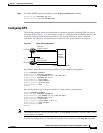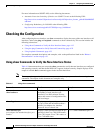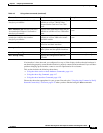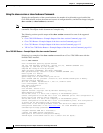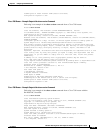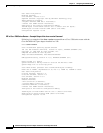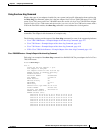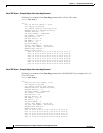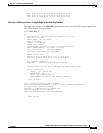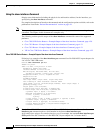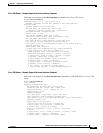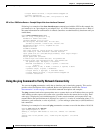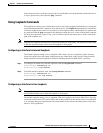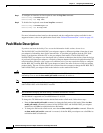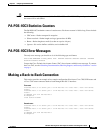
4-22
PA-POS-1OC3 Single-Port Port Adapter Installation and Configuration Guide
OL-6514-04
Chapter 4 Configuring the PA-POS-1OC3
Checking the Configuration
0 output buffer failures, 0 output buffers swapped out
0 carrier transitions
POS1/1 is administratively down, line protocol is down
VIP in Cisco 7500 Series Routers—Example Output of the show interfaces Command
Following is an example of the show interfaces pos command used with the VIP. In this example, the
pos interfaces is on a port adapter in port adapter slot 1 of a VIP in interface processor slot 1. Most of
the status information for each interface is omitted. (Interfaces are administratively shut down until you
enable them.)
Router#show interface pos 1/1/0
POS1/1/1 is up, line protocol is up
Hardware is Packet Over Sonet
Internet address is 11.0.0.1/16
MTU 4470 bytes, BW 155000 Kbit, DLY 100 usec,
reliability 240/255, txload 4/255, rxload 1/255
Encapsulation HDLC, crc 16, loopback not set
Keepalive not set
Scramble disabled
Last input 00:24:38, output 02:58:40, output hang never
Last clearing of "show interface" counters 00:00:52
Input queue:0/75/0/0 (size/max/drops/flushes); Total output drops:0
Queueing strategy:fifo
Output queue:0/40 (size/max)
5 minute input rate 366000 bits/sec, 953 packets/sec
5 minute output rate 2977000 bits/sec, 7476 packets/sec
100 packets input, 856 bytes, 0 no buffer
Received 0 broadcasts, 0 runts, 0 giants, 0 throttles
0 parity
8 input errors, 8 CRC, 0 frame, 0 overrun, 0 ignored, 0 abort
0 packets output, 0 bytes, 0 underruns
0 output errors, 0 applique, 0 interface resets
0 output buffer failures, 0 output buffers swapped out
0 carrier transitions
Using the ping Command to Verify Network Connectivity
You can use the ping command to verify that an interface port is functioning properly. This section
provides a brief description of this command. Refer to the publications listed in the “Related
Documentation” section on page viii for detailed command descriptions and examples.
The ping command sends echo request packets out to a remote device at an IP address that you specify.
After sending an echo request, the system waits a specified time for the remote device to reply. Each
echo reply is displayed as an exclamation point (!) on the console terminal; each request that is not
returned before the specified timeout is displayed as a period (.). A series of exclamation points (!!!!!)
indicates a good connection; a series of periods (.....) or the messages (timed out) or (failed) indicate a
bad connection.
Following is an example of a successful ping command to a remote server with the address 10.0.0.10:
Router# ping 10.0.0.10 <Return>
Type escape sequence to abort.
Sending 5, 100-byte ICMP Echoes to 10.0.0.10, timeout is 2 seconds:
!!!!!
Success rate is 100 percent (5/5), round-trip min/avg/max = 1/15/64 ms
Router#



